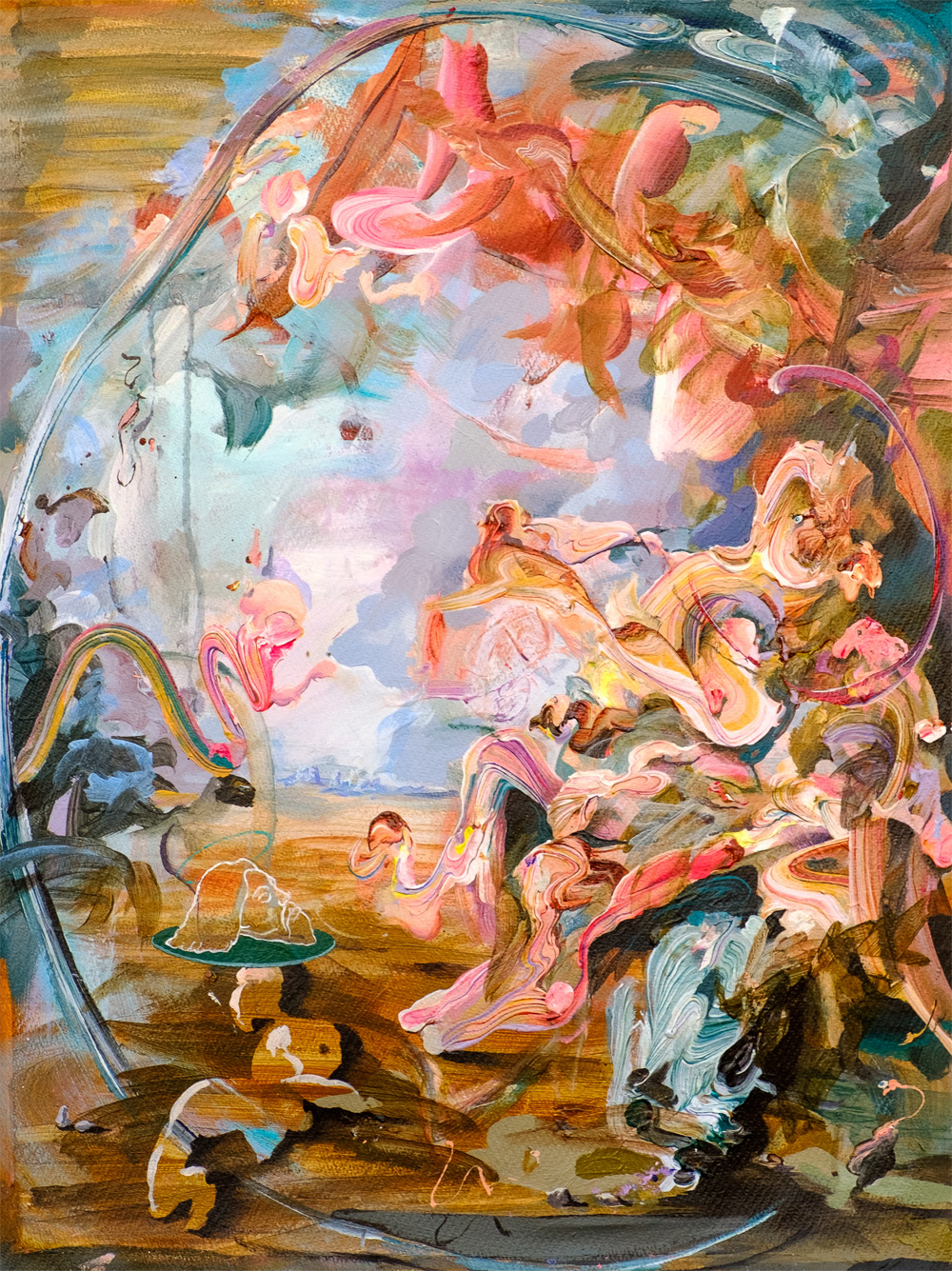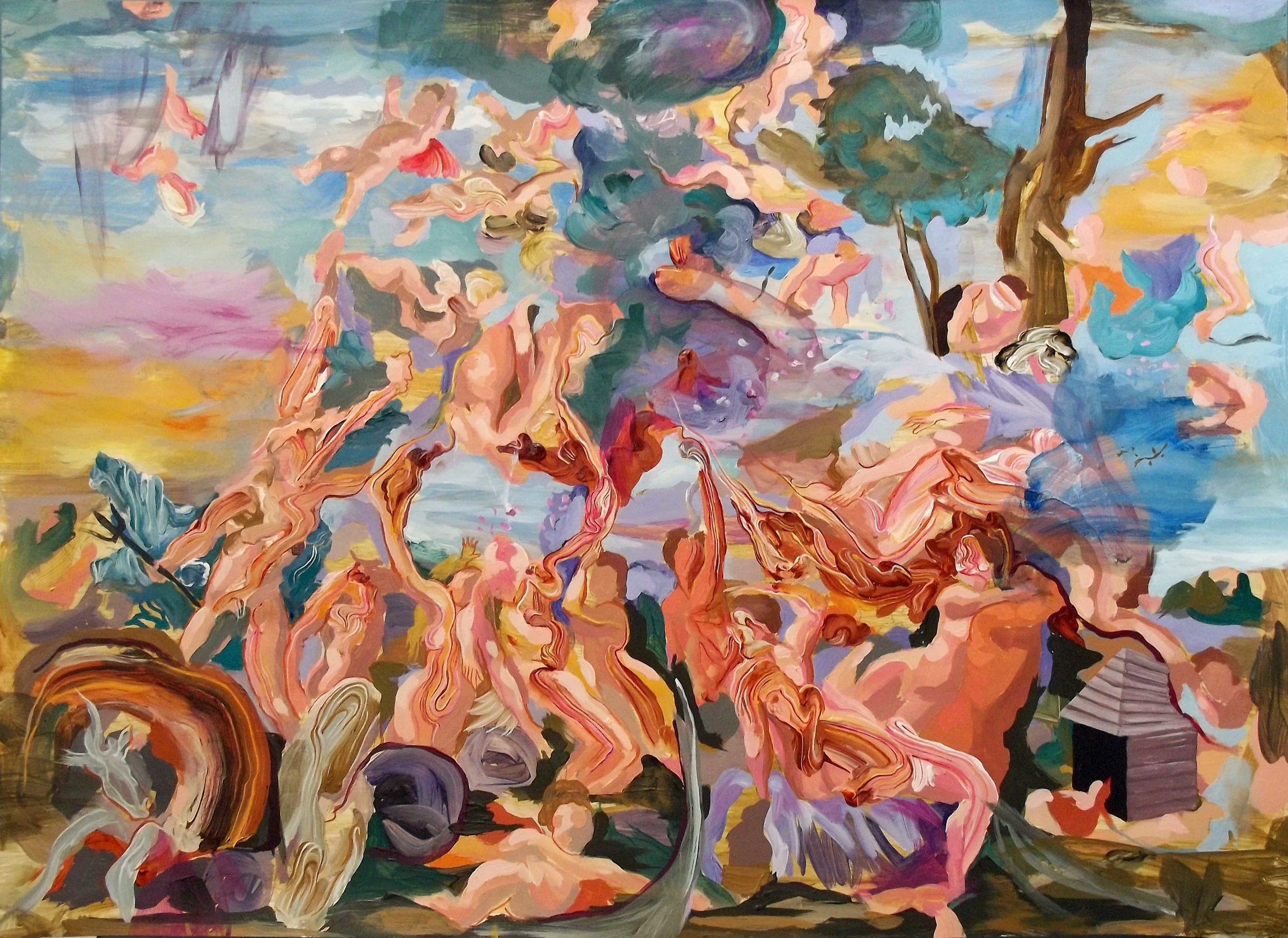Modern Alchemy: Iain Andrews on Faith, Fairy Tales and Old Masters
Charlotte Robson
Salome (2019). Acrylic on paper. Courtesy of the artist
Charlotte Robson delves into a melting pot of synaesthesia, art history and folklore as she navigates artist and art psychotherapist Iain Andrews’ endlessly layered practice.
The surrounding clamour of a Manchester city centre café could not be further, one imagines, from the private serenity of the artist’s studio. It was amidst such chaos, however, that I met the unassuming English contemporary artist and art psychotherapist, Iain Andrews, to discuss his creative practice. Andrews is currently showing four new works of acrylic on paper at the 58th Venice Biennale, presented by PAPER as part of the festival’s ‘Personal Structures’ exhibition – now in its fifth edition. The display’s theme is that of the artist’s studio, which, for Andrews, I learn, shares an important link with his one-to-one therapy work: intensity. Specifically, intensity of space, work and interaction.
Talking with Andrews, however, what emerges most clearly is the intensity of thought and concentration of knowledge demanded by his art practice. To discuss his work is to immerse oneself in a multi-layered, fantastical realm in which Old Masters and time-honoured fairy tales still reign supreme. Andrews describes his creative process as “a sort of mulching of things” – of art historical tropes and folkloric narratives, but also, indirectly, the confidential stories of abuse and neglect that he encounters in his work with vulnerable adolescents. His compositions evolve organically as much as they are authored; their success rooted in provoking an almost innate sense of strange familiarity in the viewer.
Each piece typically begins with a particular painting by an Old Master – the Rococo artists, François Boucher and Jean-Honoré Fragonard, are particular favourites – which Andrews studies, deconstructs and reassembles, jigsaw-like, until he establishes a new sketch or blueprint around which to push and squeeze his thick, gloopy paint. He explains:
“I think therapy is about retelling your story in a way that makes you stronger, and each time you retell it, it gets changed and it gets liquid. So, there’s a similarity there with the process of retelling this picture from the past visually – the way that it is torn-up, broken-down and reassembled.”
A knowledge of art history and an intellectual plasticity is therefore helpful to ‘understanding’ Andrews’ compositions on a surface level. Yet, this is not enough in itself. It is the retelling that is important. His reworking of old masterpieces is part of a deeper effort to playfully deviate from the entrenched cultural norms that they carry and represent – and to offer viewers the possibility of new readings.
Wilderness I (2019). Acrylic on paper. Courtesy of the artist
Meanwhile, though he may not set out with a particular tale in mind, the artist further frames each of his paintings within the generalised plot of a traditional Western folk or fairy story – such as ‘Hansel and Gretel’ as recorded by the Brothers Grimm, or one of Angela Carter’s relatively more modern recounts – the tale ‘attaching itself’ during the making process, as he describes. For Andrews:
“Fairy tales contain abuse, horror and abandonment, but generally lack self-pity or narcissism; presented in a way that is merely matter of fact. The structure of such stories – which often involves what J. R. R. Tolkien referred to in his essay, ‘On Fairy-Stories’ (1933), as a ‘eucatastrophe’ – introduces the possibility of redemption and transformation after the characters have passed through suffering and loss.”
To the artist’s mind, these pre-existing tales offer a structure through which he might ‘make sense of’ his conversations with clients, while also buttressing a feeling of hope. Whatever narrative emerges during a therapy session, magic tales illuminate the possibility of positive self-transformation. How plainly visible this folk narrative aspect is, differs from piece to piece. What’s most striking, however, is the alchemy by which Andrews melds and compounds the various historical and cultural elements that feed into his work to catalyse an almost chemical ‘reaction’ that unfolds across the surface of each page or canvas.
It doesn’t stop here, however; sense is yet another important ingredient brought into the alchemic reaction. A good example of this is The Temptation of Saint Anthony (2019), presently on show in Venice. A ripe visual feast, it consists of a fleshy, seething mass of commingling, almost indefinable nakedness, with softly demarcated cherubim tumbling, near fatally, out of a tempestuous petrol sky. One infers a sense of moral urgency – even disgust. Andrews’ classically curvaceous figures are decidedly dissolute; there is a distasteful air of the abject in their exposed, voracious nudity amidst a tumultuous sea of dirty brown, black and grey tones.
The Temptation of Saint Anthony (2019). Acrylic on paper. Courtesy of the artist
The artist desires a kind of greed to prevail in those that fasten or feast their eyes on his intentionally synaesthetic paintings; for the beholder to want to lick or taste the impasto paint. Like “a really gorgeous meal” or good sex, as he compares, a sheer physicality, lusciousness and very human (hence, potentially sinful or corrupt) beauty is laid bare in his work. Yet, the sanctity of his subject matter – the Christian tale of the temptation of Saint Anthony, in this case – and the tales of trauma with which each of his painterly marks are loaded, suggests a very different impulse lies at the work’s core.
Andrews’ Temptation of Saint Anthony is based on the oft-portrayed Christian story of the ‘Father of All Monks’, who was supernaturally tempted in the Egyptian desert. But it also takes Gustave Flaubert’s 1874 novel of the same name (inspired by a visit to Palazzo Stefano Balbi in Genoa, Italy, where Flaubert encountered what was then thought to have been Bruegel the Elder’s depiction of the scene) as a key point of reference. The artist states that Flaubert has been an important influence for him over the years, especially the French thinker’s notion of “a prophet/outsider/artist in the wilderness…assailed by forces that attempt to consume or corrupt.” Andrews tellingly describes the role of the artist himself as that of a rather marginal – or marginalised? – figure, on the edges of what he perceives to be today’s “homogenisation of humanity.” (When asked to expand on this ‘homogenisation’, he pointed to the bullying, multinational model of big business that underpins contemporary global capitalism and which “squashes and stamps out” original ideas. Making particular reference to the arts, Andrews suggests that, within this current climate, it is even more difficult for artists to discover their unique voice and vision.)
Amidst this perceived atmosphere of homogenisation – and, it is inferred, unbelief and atheism(s) – the artist knowingly harnesses what he believes to be the common, universal properties and values of fairy stories as a means by which to centre his practice. In response to what the art critic Peter Fuller described in Images of God: The Consolations of Lost Illusions (1985) as the “lost, shared symbolic order” in the modern absence of faith, Andrews seeks to encode his works with a communal imaginary quality. George Steiner’s seminal 1986 text, Real Presences, has also had a profound impact on his thinking. When discussing his views on modern art, the artist quoted Steiner directly to me: “Where God's presence is no longer a tenable proposition and where His absence is no longer a felt, indeed overwhelming weight, certain dimensions of thought and creativity are no longer attainable.”
Il Teatro dei Leviatano (2012-2013). Sepia ink on card with mixed media. Courtesy of the artist
An earlier paper-based work, Il Teatro dei Leviatano (The Leviathan Theatre) (2012-2013), provides the most useful, microcosmic unveiling of Andrews’ personal creative manifesto, as well as an explicit taste of one of his fairy tale-influenced offerings. Quite literally, here, it is all about what lies beneath; stories within stories. This incredibly elaborate and layered work takes the form of a three-dimensional drawing crafted by hand from card and mixed media – namely, the carapaces of insects and diminutive pieces of plastic toy soldiers – rendered in historically tinged sepia ink (originally used for writing in Graeco-Roman times, then commonly adopted by artists for drawing up until the 19th century). The title of the piece refers to the creature Leviathan, who figures in Biblical accounts as a metaphor for a powerful enemy. Peel back the allegorical curtain and the shadowy, foreboding-looking theatre structure shelters a stage upon which an analogous story of struggle against forces of doom unfolds.
Set within an intricately carved 17th-century German forest, celebrated ‘big guns’ of the pre-19th century art world, such as Raphael and Titian, symbolically portrayed as artillery, literally ‘fight back’ against the impending, apocalyptic tragedy of post-1863 modern art. Immersed within the artist’s self-created, fairy tale-inspired wilderness and haloed by an Inferno-like world of death and the grotesque in the form of the eerily haunting theatre structure itself, Andrews’ heroes do not appear to stand a chance, despite their creative resources. There is a knowing, dark humour to the way in which the artist-turned-puppet-master directs these champions of the symbolic order of the Western canon to their downfall. Revealingly, Andrews tells me that his imagined title of the play occurring on stage is ‘The Death of Painting (Long Live Drawing)’. This time-traversing work was most recently displayed at Bolton Museum and Art Gallery as part of the 2019 Greater Manchester Arts Prize for Contemporary Visual Art, for which Andrews was, for the third time, a runner-up (“always the bridesmaid”, he jokes).
Il Teatro dei Leviatano (detail). Courtesy of the artist
Il Teatro is decidedly continental, not only in terms of its Italianate title. Verily entrenched in European art history, the piece more than hints at Andrews’ encyclopaedic knowledge of Western traditional arts. Like an open book, the ‘drama’ that plays out across the piece is not backwards in coming forwards. Though delicate, and perhaps somewhat nostalgia-driven, it offers a sharp, rather cynical commentary on artmaking in the current, postmodern climate. Imbuing the drawing with another shade of meaning, the artist tells me that the painting’s ‘actors’ (Titian and company) are, in fact, also ‘stand-ins’ for his therapy clients – but he elaborates no further on this.
Andrews’ work does not make disciples easily. It forces a confrontational fixedness of gaze and a devouring grip on one’s attention, baiting you to consider multiple planes of interpretation. Though he may not hold anything ‘against’ modern art exactly, he says, there is, undoubtedly, an almost weaponising element to the intensity with which the artist compounds the Western cultural past to catalyse a questioning response to our shared contemporary context. From the private realm of his studio, Andrews’ paintings and drawings on paper emerge as a complex series of worlds folded within worlds. Endlessly rich in layers and meanings, they are truly something to behold.
‘Personal Structures’ runs at the PAPER Pavilion in Palazzo Mora until the close of the 58th Venice Biennale on 24 November 2019.





